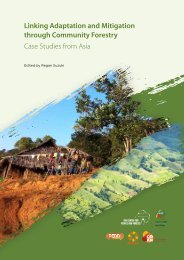Desktop Study on - Regional Climate Change Adaptation ...
Desktop Study on - Regional Climate Change Adaptation ...
Desktop Study on - Regional Climate Change Adaptation ...
Create successful ePaper yourself
Turn your PDF publications into a flip-book with our unique Google optimized e-Paper software.
<str<strong>on</strong>g>Desktop</str<strong>on</strong>g> <str<strong>on</strong>g>Study</str<strong>on</strong>g><br />
The Cagayan Valley was identified as <strong>on</strong>e of<br />
the provinces that are most affected to chr<strong>on</strong>ic<br />
flashfloods, typho<strong>on</strong>s and droughts (RMSI (2007).<br />
Between 1991 and 2005, the regi<strong>on</strong> Cagayan Valley<br />
has lost in total approximately 1 milli<strong>on</strong> t<strong>on</strong>s of palay<br />
due to flashflood and typho<strong>on</strong>s and 0.4 milli<strong>on</strong> t<strong>on</strong>s<br />
due to drought (ibid).<br />
Lansigan et al. studied agricultural impacts and<br />
differentiated the impacts of l<strong>on</strong>g-term weather<br />
variability and short-term weather episodes (2000).<br />
The effects of l<strong>on</strong>g-term climate variability include<br />
the delay of sowing date, the narrower dry seas<strong>on</strong><br />
planting period, and unnecessary water stress<br />
during the wet seas<strong>on</strong> cropping period and the<br />
resulting lower yield (ibid). The several impacts of<br />
short-term weather episodes are: high temperature<br />
induced sterility in rice that results from disturbance<br />
of pollen shedding and decreased variety of pollen<br />
grains; increasing irrigati<strong>on</strong> water requirement that<br />
is attributed to decrease in rainfall during the El Nino<br />
year and water stress at rice panicle initiati<strong>on</strong>. This<br />
leads to increase in the proporti<strong>on</strong> of unfilled grains<br />
and decrease in 1000-seed weight as well as reduced<br />
water availability at vegetative stage.<br />
Vulnerabilities and Adaptati<strong>on</strong> in the<br />
Agriculture and Food Sector<br />
The Philippines’ Initial Nati<strong>on</strong>al Communicati<strong>on</strong><br />
identified three aspects with high vulnerability to<br />
climate change-the loss of arable lands due to sea<br />
level rise; decreased soil fertility due to increased<br />
soil erosi<strong>on</strong>; and decreased crop productivity (1999).<br />
It further addressed the sec<strong>on</strong>d c<strong>on</strong>sequences of<br />
decreased crop yield: loss of food supply and loss<br />
of jobs, particularly for marginalized farmers.<br />
The adaptati<strong>on</strong> strategies recommended in the<br />
First Nati<strong>on</strong>al Communicati<strong>on</strong> c<strong>on</strong>sists of four key<br />
areas: ec<strong>on</strong>omic, technological, instituti<strong>on</strong>al and<br />
research strategies. These strategies were chosen<br />
mainly because of low implementati<strong>on</strong> cost (First<br />
Nati<strong>on</strong>al Communicati<strong>on</strong>, 1999). The Department<br />
of Agriculture have already accepted some of these<br />
recommended measures with low investment<br />
costs, compared to the planned irrigati<strong>on</strong> system<br />
development. Improved coordinati<strong>on</strong> of basic<br />
services offered by various governmental agencies<br />
are safe and judicious and optimum/efficient use<br />
of fertilizers or the so-called Balanced Fertilizati<strong>on</strong><br />
Strategy, implementati<strong>on</strong> of strategies to address<br />
the ENSO episodes, and the introducti<strong>on</strong> of new<br />
least-cost technologies such as hydrop<strong>on</strong>ics and<br />
evaporati<strong>on</strong> c<strong>on</strong>trol (ibid).<br />
In the study of Lansigan et al. (2000), vulnerability<br />
and adaptati<strong>on</strong> measure are investigated in the<br />
light of crops and crop producti<strong>on</strong> system, but not<br />
comprising enhancement of farmers’ capacity to<br />
adapt their resp<strong>on</strong>ses to changing climatic c<strong>on</strong>diti<strong>on</strong>s.<br />
The main focus of this study is the causality between<br />
vulnerability and risks of crop producti<strong>on</strong> and<br />
climate variability. The c<strong>on</strong>clusi<strong>on</strong> was that the<br />
degree of vulnerability of crops to climate changes<br />
depends mainly <strong>on</strong> the development stage of the<br />
crops at the time of weather fluctuati<strong>on</strong>. Scientific<br />
understanding of crop-climate relati<strong>on</strong>ships<br />
would c<strong>on</strong>tribute to formulating locati<strong>on</strong>-specific<br />
producti<strong>on</strong> technologies. Adaptati<strong>on</strong> measures<br />
introduced, therefore, include planting new rice<br />
varieties in unstable producti<strong>on</strong> areas that are<br />
early maturing, lodging-resistant and water-logged<br />
resistant <strong>on</strong>es.<br />
Adaptati<strong>on</strong> measures recommended by Lansigan et<br />
al. (2000) are developed by the Internati<strong>on</strong>al Rice<br />
Research Institute (IRRI). IRRI has created three<br />
new rice species grown from genetically modified<br />
seeds that have built-in traits of flood, drought<br />
and salt-tolerance (2009). In Philippines, around<br />
400,000 ha of coastal rice-growing land, 370,000 ha<br />
of rice-growing land and 1,180,000 ha of cultivated<br />
rice-growing upland are affected by salinity from<br />
sea water, flooding and drought respectively (ibid).<br />
Thus, the three new rice varieties have been invented<br />
with an aim to “help Filipino farmers grow more rice<br />
in difficult c<strong>on</strong>diti<strong>on</strong>s” through the following steps:<br />
1) increase of rice breeders and foundati<strong>on</strong> seeds<br />
by IRRI and the Philippines Rice Research Institute<br />
(PhilRice), 2) official approval 3) making basic seeds<br />
available to seed growers and selected farmers, 4)<br />
catering to other farmers by those selected; and<br />
5) other farmers gaining the overall increase in<br />
productivity of rice (ibid).<br />
The vulnerability study of the farmers in Tanauan<br />
City identified frequent intense droughts and<br />
increased market competiti<strong>on</strong> as important sources<br />
of their vulnerability (Acosta-Michlik and Espald<strong>on</strong><br />
2008). Particularly, this is evident for farmers who do<br />
not own irrigati<strong>on</strong> infrastructure, since their income<br />
are reduced by lower crop yield as well as higher<br />
producti<strong>on</strong> and marketing costs induced from public<br />
market. In the study, it was found that producti<strong>on</strong><br />
support for increasing cropping intensity of rice<br />
producti<strong>on</strong> as well as yield would c<strong>on</strong>siderably<br />
reduce vulnerability <strong>on</strong>ly if complemented with<br />
market support to increase the price of rice and/or<br />
decrease the transport costs to the market (ibid).<br />
60

















